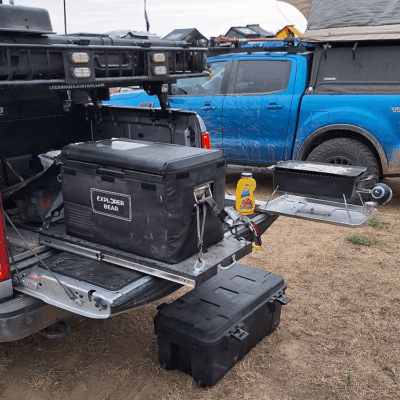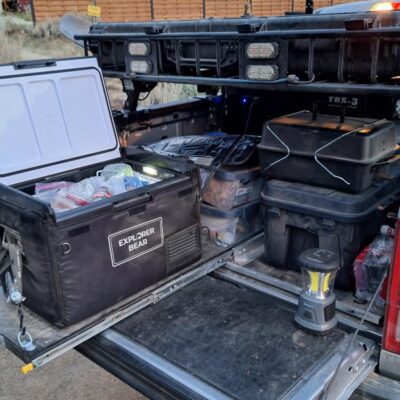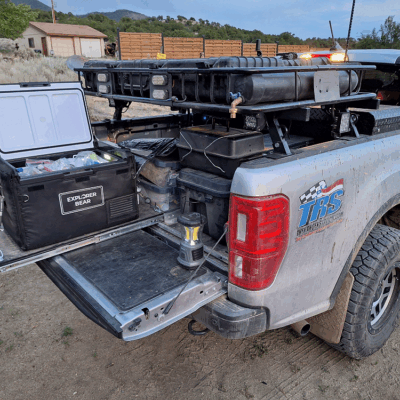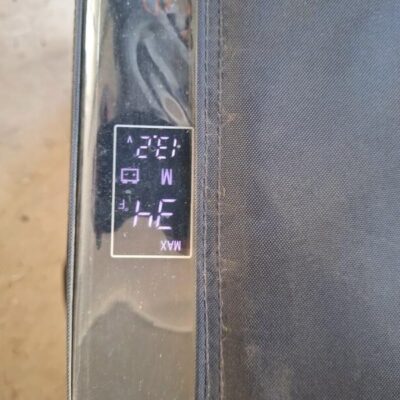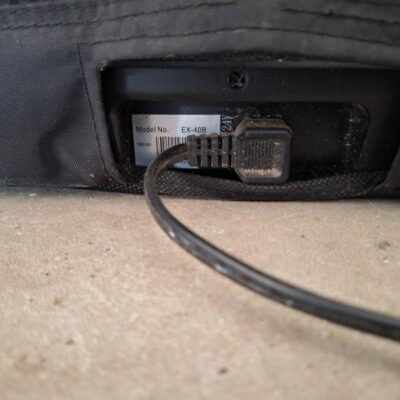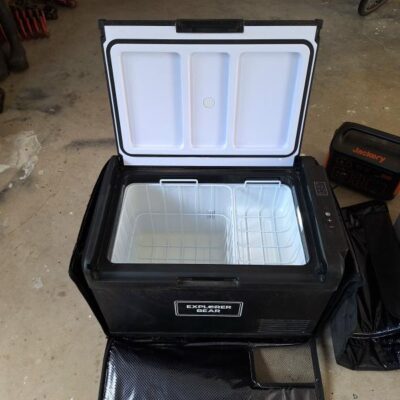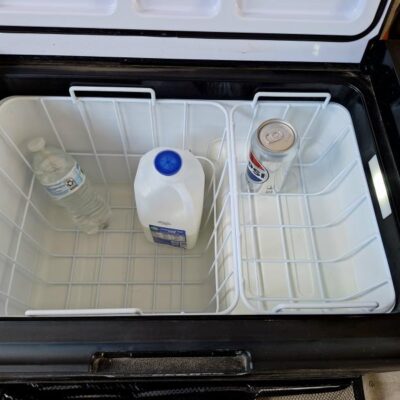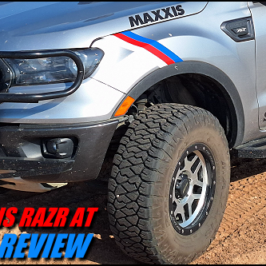
Introduction:
For several years I have been using a Lifetime 55-quart cooler which has been working great, but coolers have their disadvantages. While the cooler can keep ice for days, the ice does melt and always seems to find its way into things I don’t want it to. The other thing is that I found myself stopping every other day and topping off the ice for fear that my food would spoil. For 2025, I decided to invest in a 12-volt refrigerator.
There are a lot of 12-volt camping fridges out there for overlanders to choose from. I didn’t want to buy an expensive fridge, but I also didn’t want to buy a cheap fridge from Amazon that wouldn’t last. After doing some research, and reading reviews, I found that Uncle_Gump, one of the TRS Forum Moderators, had been using an Explorer Bear fridge and was very happy with it.
Deciding on the Explorer Bear, I now had to choose between the 42-quart (EX40B) and 52-quart (EX50B) fridges. I’ve read that you lose space in a cooler due to ice, and that a slightly smaller fridge without all of that ice can carry just as much as the larger cooler. Even though I had been using a 55-quart cooler, I decided to buy the 42-quart fridge.
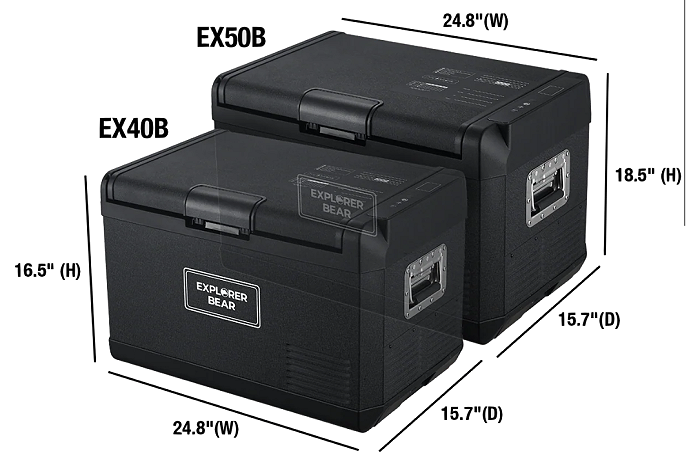
Experience & Opinion:
Since buying the fridge I’ve had the opportunity to use it on a few trips under a variety of conditions. It has travelled from Texas to Oklahoma, Colorado, and other states and has endured a lot of dirty, dusty, off-highway miles in the bed of my truck. It also spent 3-days running off of a 100 AH lithium battery at Overland Expo Mountain West, and 4-days running off of the same lithium battery at Overland of America in mid 90-degree temperatures. The fridge has worked flawlessly, maintained the temperature I’ve set it at, and will run off of my 100 AH lithium battery for at least 4-days with no problem.
The 42-quart is a good size for 2-people camping for a weekend and it will carry everything I need for 7-10 days, but if you’re overlanding as a couple for a week at a time I’d recommend going with the 52-quart version. To maximize space, I carry 4-6 drinks in the cooler and then replace the drinks I take out with ones I have stored in a plastic container. It doesn’t take very long for drinks to get cold in the fridge, so there’s no reason to keep the fridge loaded with drinks.
The Explorer Bear fridge comes with a 12-volt cord to plug it into a 12-volt outlet in your vehicle, and an AC cord and converter to plug it into a 120-volt wall outlet.
Would I recommend this refrigerator? Absolutely.
For information on my auxiliary battery setup, check out: Adding An Auxiliary Battery To A 2019+ Newer Ford Ranger
For information about adding a 12-volt outlet to your bed, check out: Adding a 12V Power Point to the Bed of A 2019-2023 Ford Ranger
Fridge or Freezer:
The 42-quart and 52-quart fridge can operate as either a refrigerator OR a freezer. It can’t do both at the same time. Explorer Bear does offer a 79-quart version that is equally divided to do both. When I’m going to be on an overlanding adventure for a week, I freeze my meats before sticking them in the refrigerator. This way I know they’ll be good for the week, and I don’t have to worry about them spoiling. I also set my fridge down to 32 degrees, so they don’t thaw to quickly, but still above freezing so nothing else freezes. Raw beef will generally keep in a fridge for 3-5 days, freezing it first can extend that time. One of my friends avoids this concern by precooking his meat so all he has to do is warm it up on the grill.
My home freezer stopped working so I used my Explorer Bear as a freezer to keep everything frozen for a couple of days until I could fix my freezer. I was surprised at how quick it got down to freezing and how quickly it froze things that had started to thaw. I’ll probably never use it as a freezer again, but I know it’s more than capable of doing it if I need it to.
Insulated Protective Cover
I purchased the insulated protective cover. Crafted from rugged, water-resistant fabric, this cover is built to withstand harsh outdoor conditions. Shield your portable refrigerator/freezer from UV rays, dust, dirt, and abrasions. I bought it to help insulate the fridge so it wouldn’t run as much but found that I really like that it helps keep the fridge itself clean when traveling long dusty roads.

Operation:
Max & ECO Mode: Power On:
1. Press & hold the power button for 3 seconds.
2. (Temperature) (Max/Eco) and (Battery Protection) Level Adjustments can be made by: pressing the setting button and use “+” and “-” button to make needed adjustments.
NOTE: I found that if I disconnect the power and reconnect it the fridge stays set at the last temperature it was set at.
Switch Between °C and °F:
With the unit shut off, press & hold the setting button for 3 seconds until you see “F1”, then you can press the setting button a few more times until you see the “CF” selection and you can use the “+” or “-” to make your selections
Tripple Battery Protection:
The triple battery protection is designed to prevent over-discharge and battery depletion. When the measured DC voltage is below the set value, the compressor will shut off to prevent battery depletion.
Battery Protection Low: Cut-out 12V at 9.6 volts / Cut-in 12V at 10.9 Volts
Battery Protection Medium: Cut-out 12V at 10.8 volts / Cut-in 12V at 11.8 Volts
Battery Protection High: Cut-out 12V at 11.3 volts / Cut-in 12V at 12.6 Volts
For example, when you switch to a LOW MODE, the battery voltage is lower than 9.6 volts, the refrigerator will automatically power off; When the battery voltage reaches 10.9 volts, the refrigerator will start again.
In the photo below you’ll see that my fridge temperature is 39 degrees, the battery protection is set at ‘M’ for medium, and the volts being used is 12.3. The fridge is actually set at 34 degrees but hadn’t dropped to that temperature yet when I took the photo. It doesn’t take very long for the fridge to cool down when you turn it on.
Weatherproof:
According to Explorer Bear, “Refrigerators can operate under light rain conditions. We DO NOT recommend exposing the fridge to moderate or heavy rain. As with all electrical appliances, over-exposure to moisture may shorten the fridges’ life. Please keep the vents clear of water, and please add some clearances to the bottom of the fridge, if the ground is wet.”
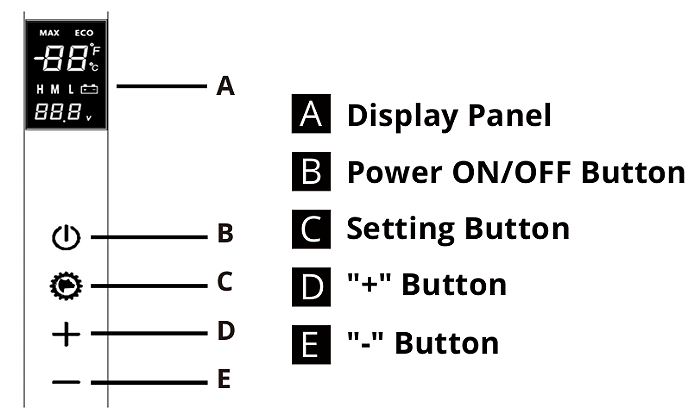
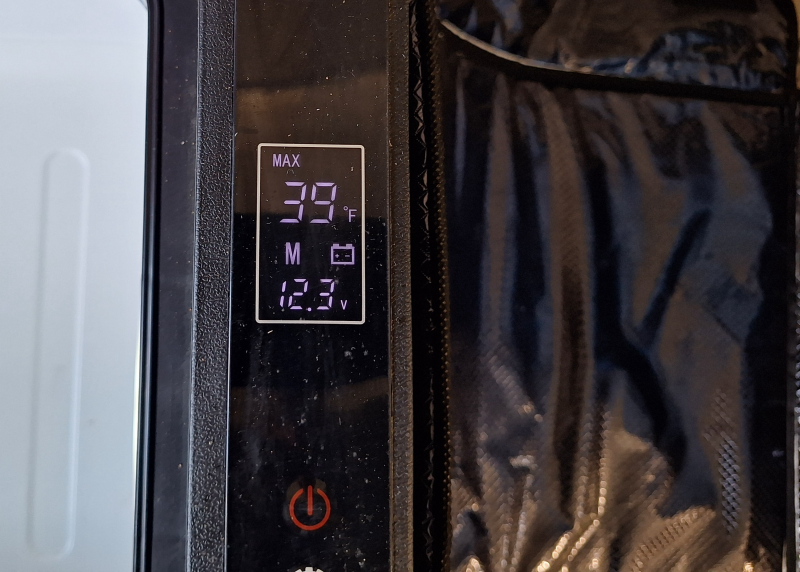
Specifications:
Product Dimension: 24.8″(W) x 16.5″(H) x 15.7″(D)
Product Weight: 40.7 LBS / 50 LBS
Total Volume: 40L/42.5QT (67 CANS)
Refrigerant Type: R134A
Refrigerant Amount: 13G
Temperature Range: 0°F TO +50°F
Energy Consumption: 2.8AH/H Ambient @77F, Internal@0F
What this means is that the fridge uses 2.8 amp hours per hour to maintain 0 degrees Fahrenheit when the temperature outside of the fridge is 77 degrees Fahrenheit. So, if it’s running off of a 100 AH battery, it should run for 35.75 hours. If you’re using it as a fridge then it’s probably set at 32-34 degrees and will consume less power. Unless it’s 109 degrees outside. LOL.
Noise Level: 45 DB
Insulation Thickness: 2-Inch
Input Voltage AC: 120V
Input Voltage DC: 2/24V
AC/DC Cable Length: 85.0-Inch / 98.4-Inch

Links:
Explorer Bear EX40B & EX50B Owner’s Manual
Video:
Gallery:
About The Author
Jim Oaks is the founder of TheRangerStation.com, the longest-running Ford Ranger resource online since 1999. With over 25 years of hands-on experience building and modifying Ford Rangers — including magazine-featured builds like Project Transformer — Jim has become one of the most trusted authorities in the Ford Ranger off-road and enthusiast space. In 2019, he was loaned a Ranger FX4 by Ford Motor Company to test and document across the TransAmerica Trail. Jim continues to inspire and guide Ranger owners around the world.

